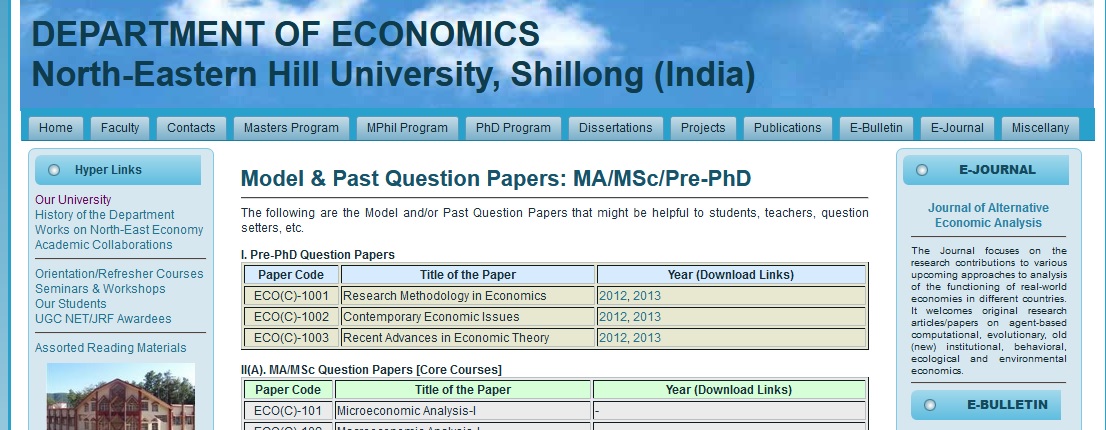MA/MSc Financial Economics Question Paper : North-Eastern Hill University
Name of the Organisation : Department Of Economics,North-Eastern Hill University, Shillong
Exam : MA/MSc Question Papers
Subject : Financial Economics
Year : 2013
Document Type : Model & Past Question Papers
Website : https://www.nehu.ac.in/
Download Model/Sample Question Paper :
Financial Economics 2012 : https://www.pdfquestion.in/uploads/13344-Fineco12.pdf
Financial Economics 2013 : https://www.pdfquestion.in/uploads/13344-FinEco13.pdf
NEHU Financial Economics Question Paper
Full Marks: 75;
Time: 3 hours
** The figures in the margin indicate full marks for the questions
** Answer five questions, selecting at least one from each Credit
Related : North-Eastern Hill University MA/MSc Labour Economics Question Paper : www.pdfquestion.in/13342.html
CREDIT – I :
1. What are the goals of financial management? Critically examine profit maximization as a criterion for financial management decisions. (3+12)
2. What is meant by ‘Time Value of Money’? Explain the concepts of ‘Present Value’ and ‘Future Value’. Discuss the compounding and discounting techniques. (3+6+6)

CREDIT-II :
3. Write an essay on the Indian Capital Market, highlighting the issue mechanism in the primary market. (15)
4. Critically examine the capital asset pricing model, giving its assumptions. (15)
CREDIT-III :
5. (a) Describe how you would determine the various components of cost of capital.
(b) A company has 15% irredeemable preference shares of the face value of Rs 100. Flotation costs are estimated at 5% of the expected sales price. Calculate the cost of capital, if the preference shares are issued at (i) par (ii) 10% discount
(iii) 10% premium. If the dividend tax is 5%, calculate the after tax cost of capital, for all the three cases above. (9+6)
6. Write short notes on the following :
(i) Debt and equity (ii) Stock dividend and stock split
(iii) Determinants of dividend policy (3×5=15)
CREDIT-IV :
7. (a) What are options? Distinguish between call option and put option with example. (2+5)
(b) Explain the following concepts relating to an option.
(i) American option (ii) European option (iii) Option premium (iv) At-the-money (4×2=8)
8. What is a financial futures contract? Discuss the various types of financial futures contracts that are traded in India. Also, write a note on the evolution of futures market in India. (3+7+5)
Financial Economics 2012 :
Full Marks: 75;
Time: 3 hours
Note :
**The figures in the margin indicate full marks for the questions
** Answer five questions, selecting at least one from each Credit
CREDIT – I :
1. (a) What are the main forms of business organization? Give their merits and demerits.
(b) Write a note on the wealth maximization criterion. (2+8)+5
2. (a) Define risk and return of a portfolio. Explain how you would calculate them, taking an example of your own.
(b) Write about the Profit and Loss account. (3+7)+5
CREDIT-II :
3. What is the money market? How does it differ from the capital market? Write about the different financial instruments that are traded in the money market. (3+3+9)
4. (a) Define equity capital. Give the salient features of equity shares.
(b) Describe the various types of debentures. (3+6)+6
CREDIT-III :
5. (a) Describe how the cost of perpetual debt and redeemable debt of a firm are calculated.
(b) A company has a 10% perpetual debt of Rs 1,45,000. The tax rate is 30%. Find out the cost of capital before tax as well as after tax, assuming that debt is issued (i) at par (ii) at 10% discount and (iii) at 10% premium. (5+4)+6
6. (a) State and prove Modigliani and Miller’s irrelevance of dividends hypothesis.
(b) Explain how dividend payout ratio, and legal and contractual obligations influence the dividend policy of a firm. (9+6)
CREDIT-IV :
7. What is a mutual fund? How is the NAV of a mutual fund calculated? Explain the different types of mutual funds that are operating in India today. (3+3+9)
8. Write notes on any two of the following: 2×7½ =15
(a) Options
(b) Different types of Swaps
(c) Forward Contract
Economics of Social Sector :
Full Marks: 75 ;
Time: 3 hours
** The Figures in the margin indicate full marks for the questions
** Answer Five questions, selecting at least one from each Credit
CREDIT – I :
1. Explain the concepts of private and social demand for education and in these perspectives give an elaborate explanation of demand for education. (5+10)
2. Explain the concept of human capital. Discuss the role of education in the process of manpower development to meet the requirements of the economic growth process of a developing country? (3+12)
CREDIT – II :
3. What is cost benefit analysis? Give a critical explanation of the cost benefit analysis in the context of the economics of education. (5+10)
4. Define the concept of educational financing? Critically evaluate the various measures that have been adopted to raise additional resources for education. (5+10)
CREDIT – III :
5. Discuss the macro-economic indicators of public health. Highlight their major international trends and position of India in recent past. (9+6)
6. Explain the concept of health as an economic good. What are the main features of demand and supply considerations of health care market? (5+10)
CREDIT – IV :
7. Critically explain the role of state in providing public health care services in India. What are the main health dimensions of development which are considered to be relevant in rural India? (8+7)
8. Write short notes on any Two: (71/2×2)
(a) Inequalities in health care services
(b) Measurement of malnutrition
(c) Theory of production of health care service
(d) Resource cost of ill health